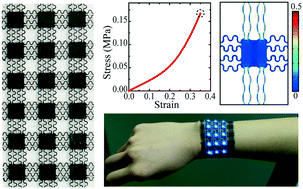Soft elastomeric composite materials with skin-inspired mechanical properties for stretchable electronic circuits†
Abstract
The stretchable version of electronic circuits harnesses commercial chip scale components to achieve complex functionality and mechanical deformability, which represents an emerging technology to expand the application of conventional electronics on rigid wafers. The bottleneck lies in the lack of a robust approach for the collective integration of off-the-shelf components into a reliable system. In this study, an elastomeric composite material with skin-like mechanical responses and spatially heterogeneous rigidity is reported as an attractive platform for stretchable circuit systems. The approach utilizes a high modulus microstructure embedded in the matrix of a soft elastomer to achieve programmable mechanical properties, thereby offering selective strain isolation for fragile components and overall protection against excessive loads. A low cost procedure involving laser ablation and blade coating is established to create the composite material matching with the circuit design. In addition, ultrasonic atomization of liquid metal into microparticles allows flexible preparations of deformable conductors in the forms of interconnects and contacts. An LED matrix is demonstrated as a prototype circuit system with excellent durability to withstand repetitive stretching and external impacts. Stretchable circuit systems based on soft elastomeric composite materials may find potential uses in health monitoring, mechatronic prosthetics, and soft robotics.

- This article is part of the themed collection: Lab on a Chip Recent HOT Articles


 Please wait while we load your content...
Please wait while we load your content...